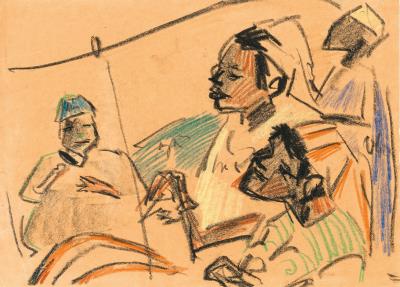Ernst Ludwig Kirchner

(Aschaffenburg 1880–1938 Frauenkirch near Davos)
Moroccans, around 1909, color crayon, charcoal on paper, on the reverse the stamp of the estate E. L. Kirchner, numbered FS Dr/Bi 13, 33 x 45 cm, framed
We are grateful to Prof. Dr. Dr. Gerd Presler for his kind notes.
Provenance:
Estate of the artist Frankfurter Kunstkabinett, Hanna Bekker vom Rath, Frankfurt am Main
New Art Center, Weintraub Gallery, New York
Private Collection, Rhode Island
Max Vater (1992)
Kunsthandel Wolfgang Werner, Bremen/Berlin (around 1992)
Private Collection, Germany
Exhibited/Literature:
Frankfurt am Main, Frankfurter Kunstkabinett, Hanna Bekker vom Rath, 1954, cat.-no. 54
Bremen/Berlin, Kunsthandel Wolfgang Werner, Expressionisten. Aquarelle und Graphiken, cat.-no. 3 with color illustration
Ernst Ludwig Kirchner’s extensive oeuvre is impressive in its strong colours and energetic contours. The present drawing, rendered in coloured chalk and charcoal, sketchily depicts four people. The outlines of the figures are rendered with only a few distinctive lines, the brightly coloured clothing is indicated with cursory hatching.
At the time of the painting’s creation in 1909, there were several ethnological expositions, so-called “Völkerschauen”, in Dresden, which Kirchner and other Brücke artists frequently attended. At these shows, people were presented as living exhibits and foreign dances and rites of their respective homelands were arranged as a spectacle. For the Brücke artists, these people served as a screen onto which the ideal image of the primordial and naturalistic human being could be projected. While Kirchner’s contemporaries pursued their fascination with the exotic by travelling to distant countries, Kirchner only experienced non-European cultures during visits to the Ethnological Museum or the aforementioned ethnological shows in Dresden. As Kirchner never left Europe, his imagination was shaped by the images he encountered at these shows, as well as in museums and in literature. Kirchner, who never went a day without his sketchbook, possessed the talent of capturing entire scenes with just a few precise strokes. He captured everything that appealed to his artistic eye.
In February 1909, Kirchner is known to have attended a performance of the Sarrasani Circus in Dresden. He watched the Moroccan acrobats and recorded their performance in the sketchbook Skb 7. Kirchner later used the sketches he made on site in numerous paintings, watercolours and prints.
Expert: Dr. Petra Maria Schäpers
 Dr. Petra Maria Schäpers
Dr. Petra Maria Schäpers
+49 211 2107747
petra.schaepers@dorotheum.de
29.11.2022 - 18:00
- Odhadní cena:
-
EUR 80.000,- do EUR 120.000,-
Ernst Ludwig Kirchner
(Aschaffenburg 1880–1938 Frauenkirch near Davos)
Moroccans, around 1909, color crayon, charcoal on paper, on the reverse the stamp of the estate E. L. Kirchner, numbered FS Dr/Bi 13, 33 x 45 cm, framed
We are grateful to Prof. Dr. Dr. Gerd Presler for his kind notes.
Provenance:
Estate of the artist Frankfurter Kunstkabinett, Hanna Bekker vom Rath, Frankfurt am Main
New Art Center, Weintraub Gallery, New York
Private Collection, Rhode Island
Max Vater (1992)
Kunsthandel Wolfgang Werner, Bremen/Berlin (around 1992)
Private Collection, Germany
Exhibited/Literature:
Frankfurt am Main, Frankfurter Kunstkabinett, Hanna Bekker vom Rath, 1954, cat.-no. 54
Bremen/Berlin, Kunsthandel Wolfgang Werner, Expressionisten. Aquarelle und Graphiken, cat.-no. 3 with color illustration
Ernst Ludwig Kirchner’s extensive oeuvre is impressive in its strong colours and energetic contours. The present drawing, rendered in coloured chalk and charcoal, sketchily depicts four people. The outlines of the figures are rendered with only a few distinctive lines, the brightly coloured clothing is indicated with cursory hatching.
At the time of the painting’s creation in 1909, there were several ethnological expositions, so-called “Völkerschauen”, in Dresden, which Kirchner and other Brücke artists frequently attended. At these shows, people were presented as living exhibits and foreign dances and rites of their respective homelands were arranged as a spectacle. For the Brücke artists, these people served as a screen onto which the ideal image of the primordial and naturalistic human being could be projected. While Kirchner’s contemporaries pursued their fascination with the exotic by travelling to distant countries, Kirchner only experienced non-European cultures during visits to the Ethnological Museum or the aforementioned ethnological shows in Dresden. As Kirchner never left Europe, his imagination was shaped by the images he encountered at these shows, as well as in museums and in literature. Kirchner, who never went a day without his sketchbook, possessed the talent of capturing entire scenes with just a few precise strokes. He captured everything that appealed to his artistic eye.
In February 1909, Kirchner is known to have attended a performance of the Sarrasani Circus in Dresden. He watched the Moroccan acrobats and recorded their performance in the sketchbook Skb 7. Kirchner later used the sketches he made on site in numerous paintings, watercolours and prints.
Expert: Dr. Petra Maria Schäpers
 Dr. Petra Maria Schäpers
Dr. Petra Maria Schäpers
+49 211 2107747
petra.schaepers@dorotheum.de
|
Horká linka kupujících
Po-Pá: 10.00 - 17.00
kundendienst@dorotheum.at +43 1 515 60 200 |
| Aukce: | Moderní umění |
| Typ aukce: | Sálová aukce s Live bidding |
| Datum: | 29.11.2022 - 18:00 |
| Místo konání aukce: | Wien | Palais Dorotheum |
| Prohlídka: | 22.11. - 29.11.2022 |
Všechny objekty umělce
